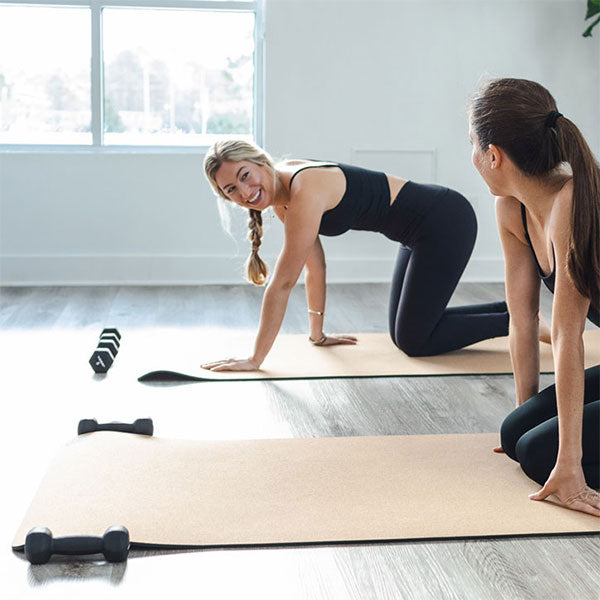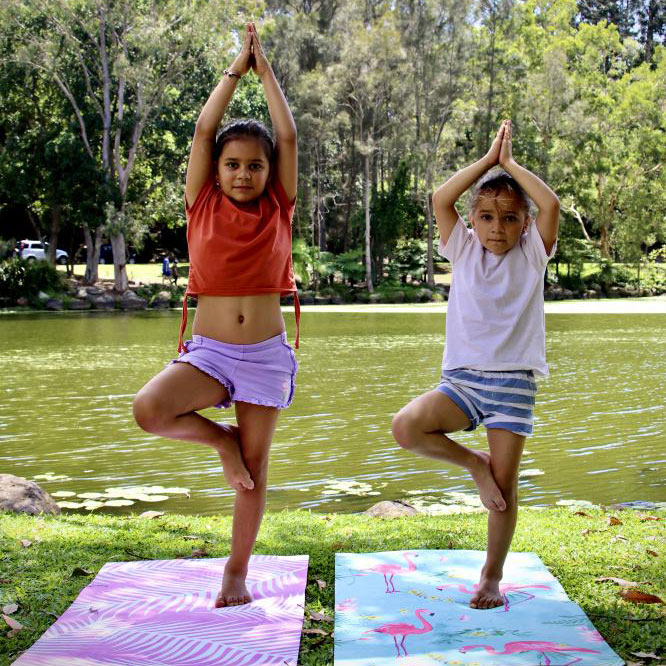Importance of Regular Cleaning
How to clean lulu yoga mat? Regular cleaning of your Lulu yoga mat is crucial for several reasons. It not only maintains the mat’s quality and grip but also ensures that it remains hygienic for every use. By establishing a routine cleaning schedule, you can extend the lifespan of your yoga mat, making your investment last longer.
Key Benefits of Keeping Your Yoga Mat Clean
- Enhanced Traction and Safety: A clean mat provides better grip, preventing slips during practice.
- Increased Longevity: Regular cleaning prevents material breakdown, extending the mat’s life.
- Hygienic Practice Space: Reduces the buildup of dirt, oils, and sweat that can harbor bacteria.
Health Risks with Unclean Mats
Unclean mats pose several health risks, making regular cleaning imperative:
- Skin Infections: Bacteria and fungi can cause skin irritations or infections.
- Respiratory Issues: Dust and allergens can affect breathing, especially for those with allergies.
- General Discomfort: A dirty mat can smell and feel unpleasant, disturbing your focus and relaxation during yoga.
Supplies Needed for Cleaning a Lulu Yoga Mat
Cleaning your Lulu yoga mat properly requires specific tools and solutions. Here’s what you’ll need to gather to effectively clean and maintain your yoga mat.
Essential Cleaning Tools
To clean your Lulu yoga mat effectively, you will need several items:
- Soft Cloth: Use a soft, non-abrasive cloth for wiping the mat.
- Spray Bottle: Handy for applying homemade or commercial cleaning solutions evenly.
- Scrub Brush: A soft brush can help remove stubborn grime without damaging the mat surface.
- Bucket or Basin: Useful for mixing cleaning solutions or soaking the mat, if needed.
- Towel: For drying the mat after washing.
These tools assist in thorough cleaning without harming the mat’s material.
Suitable Cleaning Solutions
Choosing the right cleaning solutions is critical to protect your mat and enhance its longevity. Here are some options:
- DIY Vinegar Solution: Mix one part water with one part white vinegar. This mixture helps remove odors and disinfects the mat.
- Mild Dish Soap: Use a mild dish soap diluted in water for a gentle clean.
- Commercial Yoga Mat Cleaner: Opt for cleaners designed specifically for yoga mats to ensure compatibility.
- Baking Soda: Useful for tackling tough stains or odors when mixed with water into a paste.
Use these solutions to keep your mat clean, maintain its grip, and ensure it is hygienic for each practice session.
Step-by-Step Cleaning Guide
Maintaining your Lulu yoga mat involves simple steps. Follow this guide for best results.
Daily Light Cleaning Tips
Clean your mat after each practice:
- Prepare Your Cleaning Solution: Mix water with white vinegar, or choose a mild soap.
- Use a Soft Cloth: Dampen the cloth with the solution, then gently wipe the mat’s surface.
- Air Dry the Mat: Let your mat dry fully before you roll it up or use it.
- Store Properly: Keep the mat in a clean, dry place away from direct sunlight.
These tips help keep your mat fresh and ready for your next session.
How to Perform a Deep Clean of Your Yoga Mat
For a thorough clean, do the following occasionally:
- Create a Soapy Mixture: Use mild soap and warm water.
- Submerge the Mat: Place the mat in the mixture if the material allows.
- Gently Scrub: Use a soft brush on tough grime without harming the mat.
- Rinse Well: Wash off all soap with clean water.
- Air Dry Completely: Ensure the mat is totally dry to avoid mold growth.
A deep clean removes deep-set dirt and sweat, keeping the mat in top condition.
Stain and Odor Removal
Removing stains and odors from your Lulu yoga mat keeps it fresh and hygienic.
Handling Stains on Yoga Mats
To treat stains effectively, try these tips:
- Identify the Stain: Determine if the stain is from dirt, sweat, or other sources.
- Select the Right Cleaner: Use a mild soap or a homemade baking soda paste for tough stains.
- Apply the Cleaner: Rub the cleaner gently onto the stain with a soft cloth.
- Rinse Thoroughly: After cleaning, rinse the area with water to remove soap.
- Dry Completely: Allow the mat to air dry fully; never roll up a damp mat.
These steps should help eliminate most surface stains from your yoga mat.
Solutions for Removing Odors
For odors, the following solutions may help:
- Vinegar and Water: Mix equal parts of vinegar and water and apply it lightly.
- Baking Soda: Sprinkle baking soda over the mat, let sit, then sweep off excess.
- Essential Oils: Add a few drops of essential oil like lavender to the cleaning solution for a pleasant scent.
- Air Out Regularly: Allow your mat to air out after sessions to reduce odor buildup.
- Deep Clean Occasionally: Perform a thorough clean using mild soap to tackle ingrained odors.
Implement these methods as needed to maintain a pleasant smell and a clean surface on your Lulu yoga mat.
Common Cleaning Mistakes to Avoid
Proper care extends your Lulu yoga mat’s life. Avoid these common cleaning mistakes to protect it.
Inappropriate Cleaning Agents
Using the wrong cleaners can harm your mat. Steer clear of:
- Harsh chemicals like bleach, which can degrade the mat’s material.
- Oils or solvents that might cause the mat to become slippery.
- Abrasive powders that can scratch and ruin your mat’s surface.
Choose mild soaps or specific yoga mat cleaners instead. These are safer for your mat’s longevity.
Techniques That Could Damage the Mat
Certain cleaning methods can damage your Lulu yoga mat. Make sure to avoid:
- Over-scrubbing, which can wear down the mat’s surface and grip.
- Soaking the mat fully in water (unless the manufacturer approves it), as it may cause waterlogging.
- Applying heat, like from a hairdryer or placing it in direct sunlight, which can warp or crack the mat.
Instead, use a gentle touch and allow the mat to air-dry out of the sun’s reach.
Special Considerations per Yoga Mat Type
Different yoga mats require specific cleaning methods due to their unique materials and textures.
Tips for Different Materials
- Rubber Yoga Mats: Use mild soapy water, avoid harsh chemicals.
- Cotton and Hemp Yoga Mats: It’s safe to machine wash these mats on a gentle cycle.
- Foam Mats: Wipe with a damp cloth and mild soap, no soaking.
- Polyurethane Mats: Wipe surface grime with a soft cloth and a mild detergent solution.
Each material interacts differently with cleaning agents and water.
Adjusting Techniques for Various Mat Textures
- Textured Mats: They need light scrubbing to get into grooves.
- Smooth Mats: Simply wipe with a cloth, less friction is required.
- Sticky Mats: Avoid oil-based cleaners to maintain grip.
Adjusting your cleaning technique based on the texture ensures effective cleaning without damage.
Best Storage Practices Post-Cleaning
Proper storage of your Lulu yoga mat is crucial for its maintenance. Here’s how to dry and store your mat correctly to ensure its longevity and maintain its grip and hygiene:
Ideal Ways to Dry and Store Your Mat
- Air Dry Completely: Always allow your mat to air dry fully away from direct sunlight.
- Hang It Up: If possible, hang your mat over a rack or a shower curtain rod.
- Avoid Folding: Folding can damage the material; instead, roll your mat loosely.
- Keep It Cool: Store your mat in a cool, dry place to prevent moisture buildup.
- Use A Mat Bag: For added protection, use a specialized yoga mat bag during transport.
These steps will aid in keeping your mat clean, grippy, and ready for your next session.
Impact of Proper Storage on Mat Longevity
Proper storage is key to the longevity of your Lulu yoga mat:
- Prevents Mold: Keeping your mat dry stops mold and mildew from forming.
- Maintains Shape: Rolling your mat, instead of folding, helps maintain its shape.
- Protects Texture: Storing in a cool place ensures the mat’s texture stays intact.
- Reduces Wear and Tear: Proper care reduces the need for frequent deep cleaning.
By following best storage practices, your Lulu yoga mat will last longer and support your practice better.







































